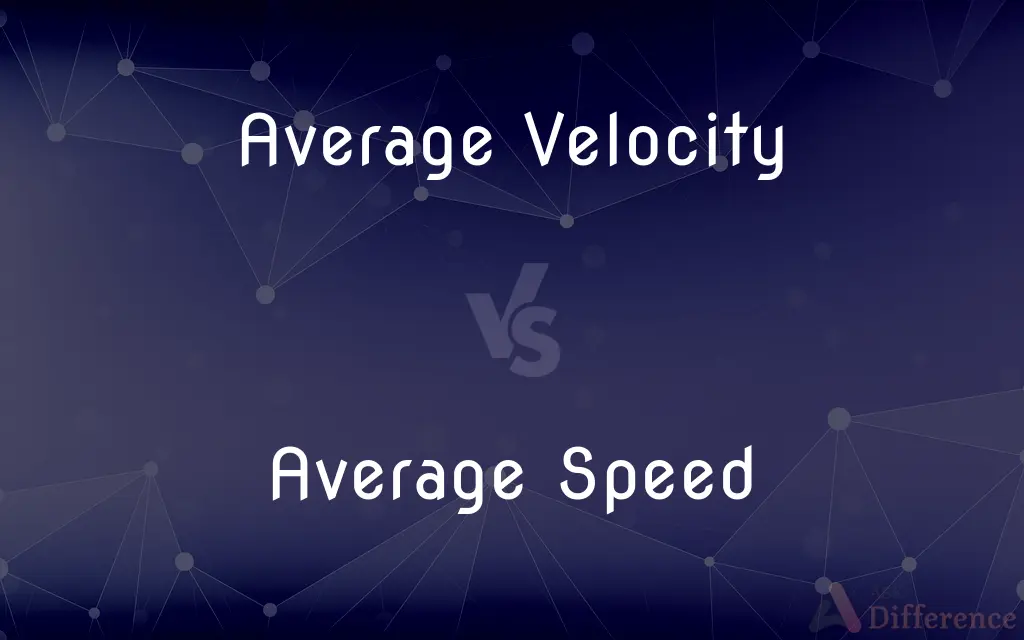Average Velocity vs. Average Speed — What's the Difference?
By Tayyaba Rehman & Urooj Arif — Published on February 6, 2024
Average velocity is the displacement divided by time, indicating direction, while average speed is the total distance traveled divided by time, irrespective of direction.

Difference Between Average Velocity and Average Speed
Table of Contents
ADVERTISEMENT
Key Differences
Average velocity is a vector quantity that describes the overall directional movement and speed of an object over a specific time period. It considers the displacement from the starting point to the ending point and the time taken. In contrast, average speed, a scalar quantity, focuses solely on how fast an object is moving, regardless of its direction, by dividing the total distance traveled by the total time.
When calculating average velocity, the direction of travel is crucial as it affects the resultant displacement. If an object returns to its starting point, its average velocity is zero because the displacement is zero. However, the average speed would still provide a positive value, as it considers the total path length traveled over the total time, disregarding the direction of travel.
In scenarios where an object moves in a straight line in one direction, average velocity and average speed can have the same magnitude. However, average velocity retains the direction component, represented as a positive or negative value or with a directional notation. Average speed remains indifferent to direction, always providing a positive value representing the rate of distance coverage over time.
Average velocity can inform about the overall effectiveness of a journey in reaching a destination, factoring in the net change in position. Conversely, average speed gives a general sense of how fast the object moved, which can be more intuitive but less informative about the object's overall progress from start to end.
In practical applications, average velocity is crucial in physics and engineering to understand motion dynamics, especially in directional contexts, while average speed is often more relevant in everyday contexts, such as determining travel times or gauging the speed of a vehicle.
ADVERTISEMENT
Comparison Chart
Definition
Displacement divided by time
Total distance traveled divided by time
Type of Quantity
Vector (magnitude and direction)
Scalar (magnitude only)
Zero Value
Possible if starting and ending points are the same
Only possible if no movement occurs
Affected by Path
No, only initial and final positions matter
Yes, depends on the length of the path traveled
Usual Context
Physics and vector analysis
Everyday use and non-directional speed measurement
Compare with Definitions
Average Velocity
It's the slope of the straight line connecting the initial and final points on a position-time graph.
According to the position-time graph, the average velocity of the train was 40 m/s towards the station.
Average Speed
Average speed is always a non-negative scalar quantity.
The marathon runner maintained an average speed of 12 km/h throughout the race.
Average Velocity
Average velocity can be negative or positive, indicating direction.
The drone had an average velocity of -5 m/s, meaning it moved westward.
Average Speed
Average speed is the total path length traveled divided by the total time of travel.
The tourist had an average speed of 4 km/h on her city walk.
Average Velocity
Average velocity is the rate of change of displacement with respect to time.
The car had an average velocity of 30 km/h east, indicating its displacement per hour towards the east.
Average Speed
It's the total length of the path divided by the total time, seen on a distance-time graph.
The distance-time graph showed that the car maintained an average speed of 60 km/h.
Average Velocity
Average velocity considers the shortest path between two points.
Even though he jogged around the park, his average velocity was 0 since he ended where he started.
Average Speed
It represents how fast an object is moving, irrespective of its direction.
The average speed of the wind was recorded at 20 m/s during the storm.
Average Velocity
It represents the net directional movement over a period.
Despite the various detours, the cyclist's average velocity was 10 km/h north.
Average Speed
Average speed does not give information about the direction of travel.
The river flowed at an average speed of 5 km/h, but its direction was not specified.
Common Curiosities
Why is average speed always a positive value?
Average speed is a scalar that represents the total distance traveled divided by time, and distance cannot be negative.
Can average velocity be zero?
Yes, if the displacement of the object is zero, meaning the starting and ending positions are the same, the average velocity is zero.
Is it possible for average speed and average velocity to have the same numerical value?
Yes, it's possible if the object moves in a straight line in one direction without changing direction.
What does average velocity indicate in physics?
Average velocity indicates the rate of change of displacement of an object over time, showing both magnitude and direction.
What is the significance of a negative average velocity?
A negative average velocity indicates that the object is moving in the opposite direction to the chosen reference direction.
How does direction affect average velocity?
Direction is integral to average velocity, as it is a vector quantity, and the sign or angle associated with it indicates the direction of movement.
Can average speed give information about the starting and ending position of an object?
No, average speed only provides information about how fast an object is moving, not about its positions.
Can the path taken affect average speed?
Yes, average speed is affected by the total path length; the longer the path, the higher the value, regardless of the object's displacement.
How do you calculate average speed if the speed varies?
To calculate average speed, divide the total distance traveled by the total time taken, regardless of speed variations.
How does returning to the starting point affect average velocity and average speed?
Returning to the starting point makes average velocity zero due to no displacement, but average speed remains positive, reflecting the total distance traveled.
In what scenarios is average velocity more useful than average speed?
Average velocity is more useful in scenarios where understanding the directional movement and displacement is crucial, such as in physics or navigation.
In a round trip, why can average speed be higher than average velocity?
Because average velocity considers displacement (which can be zero in a round trip), while average speed considers the total distance traveled, which is always positive.
Why is average speed often used in everyday contexts?
Because it provides a straightforward measure of how fast an object or person is moving, which is often more relevant for daily travel and activities.
Can both average speed and average velocity be calculated from a distance-time graph?
Average speed can be directly calculated, but average velocity requires displacement, which may not be clear from a distance-time graph without additional information about direction.
Does the shape of the path taken affect average velocity?
No, average velocity only depends on the starting and ending points, not the path's shape, unlike average speed.
Share Your Discovery

Previous Comparison
Live vs. Lives
Next Comparison
Male Blue Jays vs. Female Blue JaysAuthor Spotlight
Written by
Tayyaba RehmanTayyaba Rehman is a distinguished writer, currently serving as a primary contributor to askdifference.com. As a researcher in semantics and etymology, Tayyaba's passion for the complexity of languages and their distinctions has found a perfect home on the platform. Tayyaba delves into the intricacies of language, distinguishing between commonly confused words and phrases, thereby providing clarity for readers worldwide.
Co-written by
Urooj ArifUrooj is a skilled content writer at Ask Difference, known for her exceptional ability to simplify complex topics into engaging and informative content. With a passion for research and a flair for clear, concise writing, she consistently delivers articles that resonate with our diverse audience.
















































